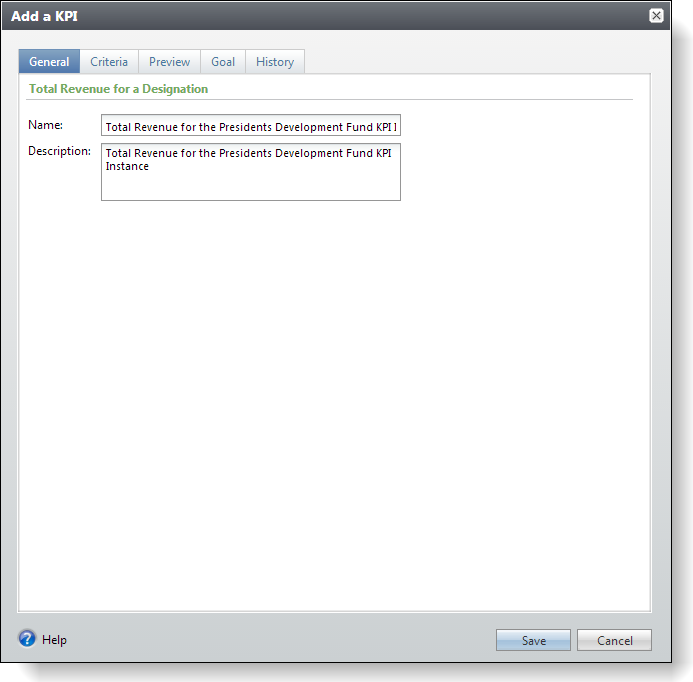Exercise: Create a KPI Instance from a KPI
Let’s create a KPI instance from a Fundraising KPI named Total Revenue for a Designation that comes standard with the Infinity-based product Blackbaud CRM.
Step 1 - Navigate to the Analysis functional area.
From Analysis, click the KPIs task. The KPIs page appears. From here, you can create, manage, and schedule updates for KPI instances. Remember that a KPI is a template and that KPI instances are created from KPIs.
From Analysis, click the Information library task. The Information Library page appears. From the KPIs tab, you can create, manage, and schedule updates for KPI instances. Remember that a KPI is a template and that KPI instances are created from KPIs.


Step 2 - Add a new KPI instance.
On the KPIs page, click the Add action above the data list. The Select a KPI screen appears.
On the KPIs tab of the Information Library page, click the Add action above the data list. The Select a KPI screen appears.
Select the KPI to use as the basis for your KPI instance. Select Total Revenue for a Designation in the Fundraising folder and click OK. The Add a KPI screen appears.


Step 3 - Add parameters for the new KPI instance.
The Add a KPI screen allows you to decorate your KPI instance. On the General tab, enter a name and description for the KPI instance.

On the Criteria tab, provide the KPI instance with parameter values such as a designation. In the Designation field, select the President's Development Fund (lookup id = DEVELOPMENT). Don’t worry about the other optional parameters right now.

On the Preview tab, you can click Preview to preview the value of the KPI on a specific date for the designation.
Step 4 - Add goals to the KPI instance.
On the Goal tab, let’s provide a goal for our KPI instance. Since we raised more than $60,000.00, I think $500,000.00 is a respectable goal. Use the table below for the options on the Goal tab.
| Property | Value |
|---|---|
| Goal value | $500,000 |
| Goal aim | High values are good |
| Good target | 450,000 |
| Satisfactory target | 250,000 |
| Milestone 1 | |
| Milestone date | 3/31/2013 (or whatever year makes sense) |
| Milestone goal | 100,000 |
| Good target | 90,000 |
| Satisfactory target | 50,000 |
| Milestone 2 | |
| Milestone date | 6/30/2013 |
| Milestone goal | 250,000 |
| Good target | 225,000 |
| Satisfactory target | 125,000 |
| Milestone 3 | |
| Milestone date | 9/30/2013 |
| Milestone goal | 500,000 |
| Good target | 450,000 |
| Satisfactory target | 250,000 |

On the History tab, select the Archive only the last radio button and enter "10" in the field. Click Save.
Step 5 - Update the KPI instance value.
Select your new KPI instance in the data list and click the Update KPI value action. The Update KPI screen appears.
Select to back date the values for the KPI from the beginning of the year to a date that makes sense (today’s date).
Click the Start button to update the value of your KPI instance.


After you click Start, you are directed to the KPI instance's page. You will see that a process has started to calculate your KPI instance value. After you create an instance, you can generate the KPI values associated with the instance settings whenever necessary. When you generate values, the selected KPI record opens, displaying details about the indicator values.


On the Goal Status tab, review your status given the first milestone.


Step 6 - Establish a job schedule for the KPI instance.
Our next step is to configure a job schedule to periodically start a process that calculates and updates the KPI instance value. You can arrange to generate KPI instnace values automatically, even during off-hours, using the Create Job Schedule option available on the KPI instance's page.
To create a job schedule, click the Create job schedule action under Tasks or the Add action on the Job Schedules tab. The Create job screen appears.
In the Job name field, enter a descriptive name for the scheduled process.
By default, the Enabled checkbox is selected to activate the process, To suspend the scheduled process, clear the Enabled checkbox.
In the Schedule Type field, select the desired frequency for the process, and then make any necessary changes to the job's frequency and duration.
To save the changes, click Save.

